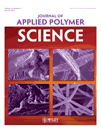Salinity effects on the degree of hydrophobicity and longevity for superhydrophobic fibrous coatings
Abstract
Previous studies on submerged superhydrophobic surfaces focused on performance variables such as drag reduction and longevity. However, to use such surfaces for practical applications, environmental factors such as water salinity must be investigated and understood. In this work, experiments were carried out to investigate the impact of salt (sodium chloride, NaCl) concentrations in aqueous solutions on the hydrophobicity and longevity of polystyrene (PS) fibrous coatings. Rheological studies using salt water as a test fluid were performed to determine the effect of salt concentration on drag reduction. Contact-angle measurements were used to validate the results from the rheometer. In situ noninvasive optical reflection was used to measure the longevity of the coating—time-dependent loss of entrapped air within the coating—as a function of salinity. The superhydrophobic coating used herein consisted of PS fibers that were deposited using DC-biased AC-electrospinning. Electrospinning is scalable and far less expensive than conventional methods (e.g., microfabrication), bringing the technology closer to large-scale submerged bodies such as submarines and ships. © 2011 Wiley Periodicals, Inc. J Appl Polym Sci, 2011




